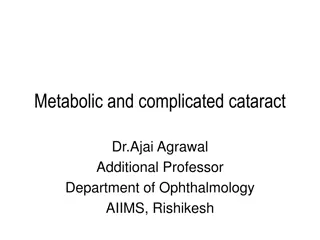Understanding Cataracts: Types, Causes, and Classification
Cataracts are characterized by lens opacity and can result from various factors like aging, trauma, or congenital issues. They are classified based on etiology and morphology, with distinct clinical types presenting different symptoms and characteristics.
Download Presentation

Please find below an Image/Link to download the presentation.
The content on the website is provided AS IS for your information and personal use only. It may not be sold, licensed, or shared on other websites without obtaining consent from the author. Download presentation by click this link. If you encounter any issues during the download, it is possible that the publisher has removed the file from their server.
E N D
Presentation Transcript
CATARACT CATARACT
Cataract is any opacity of lens, or its capsule either due to formation of opaque lens fibres or due to degenerative process leading to opacification of normally formed lens fibres
CLASSIFICATION OF CATARACT Etiological classification Etiological classification Congenital and developmental cataract Acquired cataract Senile cataract Traumatic cataract Complicated cataract Metabolic cataract Electric cataract Radiational cataract Toxic cataract Cataract associated with skin and osseous diseases
Morphological Morphological classification classification Capsular cataract Subcapsular cataract Cortical cataract Supranuclear cataract Nuclear cataract Polar cataract
CONGENITAL AND DEVELOPMENTAL CATARACT It occurs due to some disturbance in the normal growth of the lens Etiology Malnutrition Maternal infections Drugs ingestion Radiation Birth trauma
Clinical types Clinical types Congenital capsular cataract Polar cataract Congenital nuclear cataract Cataracta pulverulenta Lamellar cataract Sutural and axial cataract Total nuclear cataract Generalized cataract Coronary cataract Blue dot cataract Total congenital cataract Congenital membranous cataract
Congenital capsular cataract Anterior capsular cataract- non axial, stationary and visually insignificant Posterior capsular cataract- rare
Polar cataract Anterior polar cataract- involves central part of anterior capsule and adjoining superficial most cortex -may be due to delayed development of anterior chamber or corneal perforation Posterior polar cataract- very common lens anomaly consists of a small circular circumscribed opacity involving the posterior pole
Congenital nuclear cataracts Cataracta centralis pulverulenta-embryonic nuclear development, bilateral, small rounded opacity exactly in the centre of lens- powdery appearance and usually does not affect the vision
Lamellar cataract or zonular cataract- developmental cataract in which opacity occupies a discrete zone in the lens, common type presenting with visual impairment - occurs in a zone of fetal nucleus surrounding the embryonic nucleus
Sutural and axial cataract- punctate opacities scattered around interior and posterior Y sutures, usually static, bilateral and do not have much effect on vision
Total nuclear cataract- involves embryonic and fetal nucleus , characterized by dense chalky central white opacity seriously impairing vision, bilateral, non- progressive
Generalized cataracts Coronary cataract-common form of developmental cataract occurring at puberty, involves adolescent nucleus or deeper layer of cortex -opacities are often many in number, have a regular radial distribution in the periphery of lens
Blue dot cataract- cataracta punctata caerulea, - it forms in the first two decades of life - opacities in the form of rounded bluish dots
Total congenital cataract - important cause is maternal rubella - maternal rubella infection during first trimester may cause rubella cataract - rubella cataract- typically child is born with a pearly white nuclear cataract, progressive type
Congenital membranous cataract- total or partial absorption of congenital cataract, leaving behind thin membranous cataract
ACQUIRED CATARACT Opacification occurs due to degeneration of already formed lens
Age related cataract Age related cataract SENILE CATARACT Usually above 50 years of age Morphologically it occurs in two forms, Cortical [soft cataract] Nuclear[hard cataract]
Maturation of cortical type Maturation of cortical type Stage of Lamellar Separation Stage of incipient cataract Immature senile cataract Mature senile cataract Hypermature senile cataract
STAGE OF LAMELLAR SEPERATION The earliest senile change is demarcation of cortical fibres owing to their separation by fluid Demonstrated by slit lamp examination These changes are reversible
STAGE OF INCIPIENT CATARACT Early detectable opacities with clear areas in between them are seen Two types- Cuneiform senile cortical cataract- wedge shaped opacities with clear areas in between. On oblique illumination, typical radial spoke like pattern of greyish white opacities Cupuliform senile cortical cataract- saucer shaped opacity develops
IMMATURE SENILE CATARACT Opacification becomes more diffuse and irregular The lens appears greyish white but clear cortex is still present so iris shadow is visible Intumescent cataract- lens may become swollen due to continued hydration
MATURE SENILE CATARACT Opacification becomes complete Lens becomes pearly white It is labelled as ripe cataract
HYPERMATURE SENILE CATARACT Morgagnian- after maturity the whole cortex liquefies and lens is converted into a bag of milky fluid, the small nucleus settles at the bottom Sclerotic-the cortex becomes disintegrated and the lens becomes shrunken due to leakage of water. The anterior capsule is wrinkled and thickened, a dense white capsular cataract may be formed in the pupillary area
Maturation of nuclear cataract Maturation of nuclear cataract Progressive nuclear sclerotic process renders lens inelastic and hard, decreases its ability to accommodate and obstructs the light rays The nucleus may become diffusely cloudy(greyish) or tinted(yellow to black) The common pigmented nuclear cataracts are amber, brown(cataracta brunescens) or black(cataracta nigra) and rarely reddish (cataracta rubra) colored
CLINICAL FEATURES SYMPTOMS Glare
UNIOCULAR POLYOPIA COLORED HALOS
Black spots in front of eyes Image blur Deterioration of vision
CLINICAL SIGNS EXAMINATION NUCLEAR ISC MSC HMSC (M) HMSC (S) HM+ TO PL+ VISUAL ACUITY 6/9 TO PL+ 6/9 TO CF+ PL+ PL+ Greyish white Pearly white Color of lens varies Milky white Dirty white - IRIS SHADOW + - - - DISTANT DIRECT OPHTHALMOSC OPY Central dark area against red glow Multiple dark areas No red glow No red glow No red glow SLIT LAMP EXAMINATION Nuclear opacity, clear cortex Normal areas with cataractous cortex Complete cortex is cataractous Milky white cortex with sunken brown nucleus Shrunken lens & thickened ant. capsule
COMPLICATIONS Phacoanaphylactic cataract Lens induced glaucoma Subluxation or dislocation of lens
METABOLICCATARACT DIABETIC CATARACT Senile cataract in diabetics True diabetic cataract- snow flake cataract or snow storm cataract
GALACTOSAEMIC CATARACT Inborn error of galactose metabolism occurs in two forms - Classical Galactosemia- deficiency of GPUT - Defeciency of galactokinase B/L cataract oil droplet central lens opacities Lens changes are preventable if milk and milk products are eliminated from the diet if diagnosed early
HYPOCALCEMIC (TETANIC ) CATARACT Parathyroid tetany atrophy or removal of parathyroid glands Multicoloured crystals or small discrete white flecks of opacities in cortex rarely mature Infants hypocalcemia- zonular cataract- thin opacified lamella deep in the infantile cortex
Cataract due to error of copper metabolism wilsons disease (Hepatolenticular degeneration) Sunflower cataract - yellowish brown spots due to deposition of cuprous oxide in the ant.capsule and subcapsular cortex in stellate pattern Kayser-Fleischer ring- golden ring due to deposition of copper in peripheral part of decemets Membrane in cornea
Cataract in LOWES SYNDROME Oculo-cerebral-renal syndrome- rare inborn error of AA metabolism Ocular features congenital cataract, glaucoma, blue sclera Systemic features mental retardation, dwarfism, osteomalacia, muscular hypotonia, frontal prominence
COMPLICATED CATARACT Opacification of lens secondary to some other intraocular disease ETIOLOGY Lens depends on intraocular circulation of fluids for its nutrition- any disturbance in this leads to cataract
Etiology Etiology Inflammatory iridocyclitis, parsplanitis, choroiditis, endophthalmitis Degenerative Retinitis pigmentosa, myopic chorioretinal degeneration Retinal detachment in long standing cases Glaucoma- disturbance of intraocular circulation Intraocular tumours RB, melanoma
Clinical features Clinical features Starts as post.subcapsular cortical cataract In the beam of slit lamp opacities have- Breadcrumb appearance Polychromatic luster- characteristic sign (rainbow cataract) Diffuse yellow haze in the adjoining cortex Dirty white or chalky white appearance
DRUG INDUCED CATARACT CORTICOSTEROID post.subcapsular cataract -children are more susceptible MIOTICS ant.subcapsular granular type (long acting cholinesterase inhibitors like ecothiophate, disopropyl flourophosphate ) Others like Amiodarone, chlorpromazine, busulphan, gold
RADIATIONAL CATARACT Infrared cataract prolonged exposure may cause discoid posterior subcapsular opacities. Typically seen in persons working in glass industries, also called as glass blowers or glass workers cataract Irradiation cataract X-rays, -rays or neutrons UV-radiation causes senile cataract
Electric cataract After passage of powerful current through the body Starts as punctate subcapsular opacities which mature rapidly
PREOPERATIVE EVALUATION GENERAL MEDICAL EXAMINATION to exclude any systemic diseases like Diabetes mellitus, hypertension, COPD, any source of infection like UTI, septic gums
OCULAR EXAMINATION VISUAL STATUS ASSESSMENT -Visual acuity -PL- absence of PL indicates nil visual prognosis -PR- inaccurate PR causes-old RD, Visual pathway defects, advanced glaucoma, large area of chorio retinal atrophy and sometimes even in dense cataract
PUPILS - Light reaction, RAPD -Ability of the pupil to dilate adequately before the surgery ANTERIOR SEGMENT -Cornea : scarring -KPs ( keratic precipitates) -Cataractous lens: morphology, maturity, grade of nuclear sclerosis -Other signs Post.synechiae, pigments on ant.capsule, AC- depth
IOP Lids, Conjuntiva, lacrimal apparatus conjunctivitis, meibomitis, blepharitis, dacrocystitis- lacrimal syringing Fundus examination- to rule out other causes of decreased vision Macular function tests -Two-light discrimination test -Maddox rod test -Color perception -Entopic visualization
Objective tests if retinal pathology suspected-EOG, ERG, ultrasonic evaluation of Post.segment of the eye Keratometry and Biometry
THANK YOU THANK YOU























